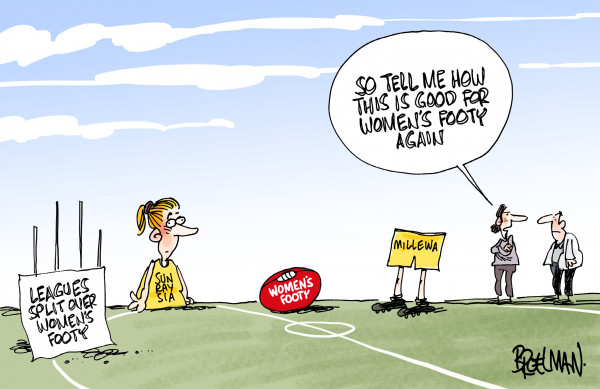THE Sunraysia and Millewa leagues have never been two peas in a pod.
Both comps have different values and because they’re each other’s only competitors, it’s only natural they clash heads with one another.
I haven’t grown up here, so I don’t understand the politics between the two, but one thing I have been able to observe in my 16 months in the region is that both the organisation’s stakeholders suffer because of their inability to work together.
A prime example is the current state of female football.
In October last year, with the recommendation of the AFL Sunraysia Commission, the senior women’s competition transitioned to Millewa management and branding.
AFL Sunraysia regional manager Ange Ballinger explained how it played out.
“Previously the (Sunraysia Women’s Football League) was created and co-ordinated by AFL Sunraysia staff,” Ballinger said.
“The AFL Sunraysia Commission is an entity to guide and promote football in the region and once it was determined that as the (SWFL) was well established in the area, it was necessary for AFL Sunraysia staff to package up and pass the program on to a willing recipient.
“The AFL Sunraysia Commission received an in-person presentation from each league in October 2023 and then a decision was made on the merit of each presentation. Following this process a transition of the (SWFL) to the MFNL occurred.”
However, the under-15 girls competition remained up for debate, with both leagues signalling their intent to hold a competition.
Hold on a minute.
Is there room for two junior girls competitions?
Six clubs feature in the Millewa competition for both men’s football and women’s netball, but in the women’s senior football competition, there’s only four consistently fielding full teams.
Nangiloc currently doesn’t play and Meringur, while they’ve put in extensive effort, have been unable to attract meaningful numbers.
Girls could obviously play two nights, but that would mean extra commitment and I doubt parents would warm to that.
The Sunraysia league has varied between under-13, 14 and 16 girls competitions since 2022, so it’s understandable they’d want some return for their investment.
Losing all female footy would mean they’d wasted their time and money.
Meanwhile, the Millewa, which has been synonymous with the senior competition for years, expected to hold a junior competition before the women.
The result ended up being a Sunraysia competition on Friday nights, initially featuring five teams, but reduced to four due to numbers.
The Millewa haven’t ruled out putting forward a competition in the future, but at the moment they don’t have one.
I can understand both arguments, they both have merit, but there comes a point where you have to question what is genuinely best for the female footy in the region.
SFNL executive officer Jason Torney acknowledged the history of the two leagues.
“When you have two leagues of the same district with clubs trying to attract the same cohort, footballers and netballers, whether it is men’s, women’s, boys or girls, there is going to be an ‘us versus them’ mentality and this invariably creates the administrative stand-off,” Torney said.
“In some respects, this creates the healthy edge that keeps both leagues striving to continually be at their best, but conversely there is no doubt more transparent communication between the leagues may provide other win-win results that enhances the prosperity of Sunraysia community sport.”
Torney said the two leagues had recently met to discuss the best strategy moving forward for girls looking to further their football through the V/Line Cup, the state’s premier under-15 competition for country players.
Millewa director of women’s football Donica Foster did not hold back when asked about her opinion of women’s football in the region.
“More community cohesion is needed to bring girls and women’s footy together,” Foster said.
“I believe the Millewa FNL need to have a junior girls competition feeding the women’s footy and I don’t think this will happen while there is the SFNL competition.”
Furthermore, Sunraysia Daily asked if she could see the leagues working together to deliver women’s programs in the future.
“I would love to see that, as the main priority is getting girls playing footy and being supported in their pathway,” Foster said.
So, both leagues have acknowledged more unity would benefit women’s footy – that’s great.
The tension of the past may run deep, but I haven’t been here to experience that.
The sport has skyrocketed in popularity around the country over the last decade and quite simply, girls deserve a pathway.
At the end of last year, the average pay for an AFLW player was $59,838 and the minimum $51,290, according to the competition’s collective bargaining agreement.
But, without an optimal junior program, the development of young talent is slowed, putting Sunraysia behind the eight-ball – the rest of the state and country.
Sport leagues should strive to provide their members the best service they can.
Of course, there are limitations to that, especially in an isolated region, so being united is worth its weight in gold – or goals.








